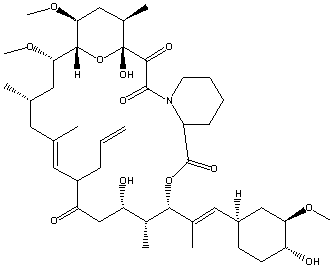
Structure of FK506
Alternative Treatments
The most commonly used immunosuppressives are currently cyclosporin and FK506. Both of these work in a different way to rapamycin by inhibitng calcineurin in the T-cells. Although it works in a very different way, FK506 binds to FKBP in exactly the same way rapamycin does and shows strucural similarities to it.

Structure of FK506
You can see from the structure above that the right hand side of FK506 is almost identical to that of rapamycin. This is also the region through which both molecules bind to FKBP. Therefore rapamycin and FK506 compete for the same binding sites, resulting in FK506 having an antagonistic effect on rapamycin when the two drugs are used together. Cyclosporin on the other hand does not bind to FKBP, but to cyclophilin and has a totally different structure so in combination with rapamycin has a synergistic immunosuppressive effect.
The main disadvantages of alternative drugs are that they must be taken for the rest of the patient's life and do not guarantee long term survival of the organ as 55% of transplanted kidneys fail within ten years. Because of the suppression of the entire immune system they also make patients susceptible to viruses, bacteria and cancer.
Side effects of cyclosporin:
The side effects of cyclosporin are thought to be largely due to its mode of action in inhibiting calcineurin. Side effects have also been reported for rapamycin, althogh these are generally less serious.
Side effects of rapamycin: